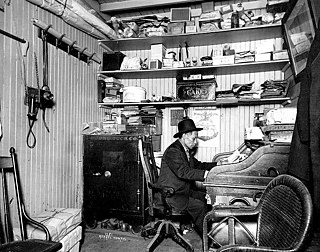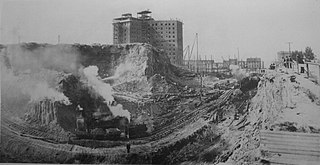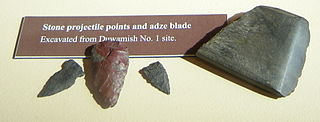
John Muir, also known as "John of the Mountains" and "Father of the National Parks", was an influential Scottish-American naturalist, author, environmental philosopher, botanist, zoologist, glaciologist, and early advocate for the preservation of wilderness in the United States of America.

Alki Point is a point jutting into Puget Sound, the westernmost landform in the West Seattle district of Seattle, Washington. Alki is the peninsular neighborhood on Alki Point. Alki was the original settlement in what was to become the city of Seattle. It was part of the city of West Seattle from 1902 until that city's annexation by Seattle in 1907.

Thornton Creek is 18 miles (29 km) of urban creeks and tributaries from southeast Shoreline through northeast Seattle to Lake Washington. Its 12-square-mile (31 km2) watershed, the largest in Seattle, exhibits relatively dense biodiversity for an urban setting; it is home to frogs, newts, ducks, herons, and beavers, in addition to more than 75,000 people. From west of Jackson Park Golf Course in Shoreline, from Sunny Walter-Pillings Pond in Licton Springs–North College Park, and north Northgate Thornton Creek flows through Maple Leaf and Lake City, including the Victory Heights, Meadowbrook, and Matthews Beach neighborhoods, and empties into the lake at Matthews Beach Park.
Ellen Meloy was an American nature writer.
Marvin Hartley Bell was an American poet and teacher who was the first Poet Laureate of the state of Iowa.
The term seven hills of Seattle refers unofficially to the hills the U.S. city was built on and around, though there is no consensus on exactly which hills it refers to. The term has been used to refer to several other cities, most notably Rome and Constantinople.

Rainier Beach is a set of neighborhoods in Seattle, Washington that are mostly residential. Also called Atlantic City, Rainier Beach can include Dunlap, Pritchard Island, and Rainier View neighborhoods.

Robert Michael Pyle is an American lepidopterist, writer, teacher, and founder of the Xerces Society for Invertebrate Conservation. Much of his life story is told in the 2020 feature film The Dark Divide, where Pyle is played by David Cross.

Daylighting can be defined as "opening up buried watercourses and restoring them to more natural conditions". An alternative definition refers to "the practice of removing streams from buried conditions and exposing them to the Earth's surface in order to directly or indirectly enhance the ecological, economic and/or socio-cultural well-being of a region and its inhabitants". The term is used to refer to the restoration of an originally open-air watercourse, which had at some point been diverted below ground, back into an above-ground channel. Typically, the rationale behind returning the riparian environment of a stream, wash, or river to a more natural state is to reduce runoff, create habitat for species in need of it, or improve an area's aesthetics. In the UK, the practice is also known as deculverting.

Matthew Zapruder (1967) is an American poet, editor, translator, and professor.
Terry Tempest Williams, is an American writer, educator, conservationist, and activist. Williams' writing is rooted in the American West and has been significantly influenced by the arid landscape of Utah. Her work focuses on social and environmental justice ranging from issues of ecology and the protection of public lands and wildness, to women's health, to exploring our relationship to culture and nature. She writes in the genre of creative nonfiction and the lyrical essay.

David L. Hough is an American writer on motorcycle rider safety, education and training. He has been a columnist for Motorcycle Consumer News, Sound RIDER! and BMW Owners News magazines. After his first book Proficient Motorcycling was published by Bow Tie Press it became one of the best selling motorcycle books. He currently has four published books and one 2nd ed. He has been recognized twice as a writer by the Motorcycle Safety Foundation's (MSF) Excellence in Motorcycle Journalism award.

Chin Gee Hee, courtesy name Chàngtíng (暢庭), Cheun Gee Yee, was a Chinese merchant, labor contractor, and railway entrepreneur, who made his fortune in Seattle, Washington before returning to his native village in Guangdong province, where he continued his successes.

The topography of central Seattle was radically altered by a series of regrades in the city's first century of urban settlement, in what might have been the largest such alteration of urban terrain at the time.

The Duwamish Number 1 Site, also known as 45KI23, is an archaeological site on the Duwamish River in Seattle, Washington discovered by David Munsell, an archaeologist employed by the U.S. Army Corps of Engineers, in November 1975. The site was excavated by archaeologists in 1978, and again in 1986.

Arthur Sze is an American poet, translator, and professor. Since 1972, he has published ten collections of poetry. Sze's ninth collection Compass Rose (2014) was a finalist for the 2015 Pulitzer Prize for Poetry. Sze's tenth collection Sight Lines (2019) won the 2019 National Book Award for Poetry.

Tony Angell is an American wildlife artist, environmental educator, and writer. He has lived in Seattle, Washington, since 1959.

Glacial erratic boulders of King County are large glacial erratic boulders of rock which were moved into King County, Washington by glacial action during previous ice ages.
Hills in the Puget Lowland, between the Cascades and the Olympic Mountains, including the entire Seattle metropolitan area, are generally between 350–450 feet (110–140 m) and rarely more than 500 feet (150 m) above sea level. Hills are often notable geologically and for social reasons, such as the seven hills of Seattle.

Lake Lenore Caves State Park is a Washington State Park in the Lenore Canyon extending into the hills from the shore of Lake Lenore. It is part of the Ice Age Floods National Geologic Trail. Lake Lenore and the rock shelter "caves" were caused by basalt coulee cliffs underscoured by the Missoula floods, the same floods that created the Channeled Scablands.















